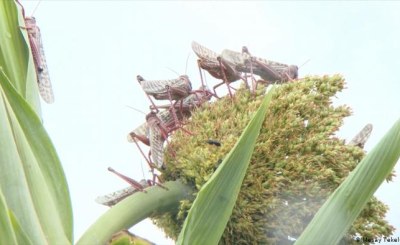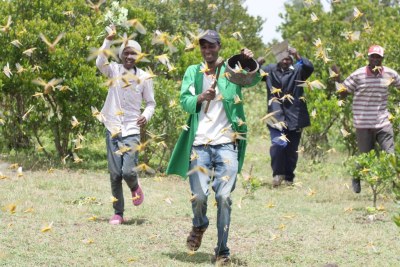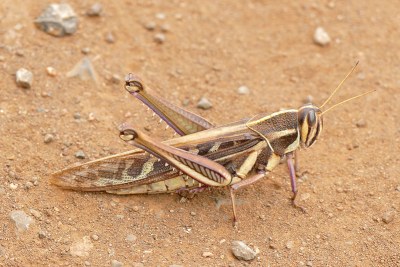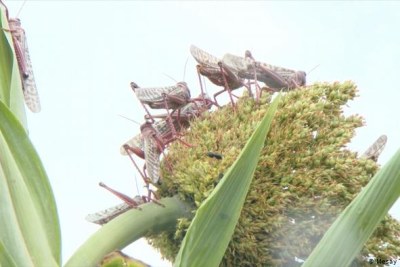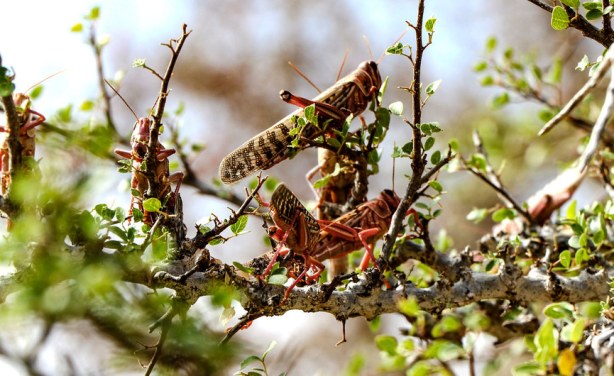-
East Africa: FAO Warns Danger Posed By Desert Locust Swarms Is Far From Over
East African, 29 April 2021
The desert locust swarms are on the decline in the East African region largely due to large-scale control operations mounted by governments and supported by FAO over the past 14… Read more »
-
South Africa: Brown Locusts Have Survived a Long Drought - Here's How
The Conversation Africa, 22 April 2021
The Northern Cape and Eastern Cape provinces of South Africa recently experienced their longest drought in 100 years. The seven year drought, starting with lack of rains in… Read more »
-
Namibia: Communities Urged Not to Eat Locusts
Namibian, 20 April 2021
COMMUNITIES in the northern regions, which have recently been invaded by large swarms of African migratory locusts, have been urged to avoid feasting on the insects. Read more »
-
Zimbabwe: Locust Outbreak Ravages Parts of Zimbabwe
The Herald, 12 March 2021
Farmers in Masvingo, Chiredzi and parts of Manicaland are battling a new round of locust outbreaks with swarms of a local type of species damaging their sorghum and maize crops, a… Read more »
-
Namibia: Public Warned Against Inhaling Locust Pesticide
New Era, 20 April 2021
Communities in locust-infested areas are advised not to inhale the pesticide during spraying operations. Read more »
-
Ethiopia: 'Fight Against Locust Invasion Shows Progress'
Reporter, 27 February 2021
The scale of spring breeding of Locusts is expected to be limited because of the ongoing control operations that continue to reduce the number of swarms and the likelihood of poor… Read more »
-
Zimbabwe: Govt Acts On Locust Outbreak
The Herald, 25 January 2021
Zimbabwe is mobilising resources to take adequate preventive measures following sightings of locusts that swept through parts of Namibia, hitting grasslands, trees and 50 000… Read more »
Danger Posed By Desert Locust Swarms Is Not Over For Africa
Swarms of locusts have damaged hectares of cropland in East Africa and some southern African countries including Namibia and Zimbabwe. In East Africa the desert locust swarms have decline largely due to large-scale control operations mounted by governments and supported by the UN Food and Agriculture Organization (FAO), for the past 14 months. Compared to the mega swarms of 2020, the swarms now being treated by government teams, run from a few hectares to 30 hectares and contain far fewer insects. Cyril Ferrand, Manager of FAO's Desert Locust response in East Africa has said that "locust control operations prevented the loss of four million tonnes of cereal and 790 million litres of milk production, protecting the food security of 34.2 million people and avoiding U.S.$1,54 billion in cereal and milk losses. Swarms in Ethiopia, Kenya and Somalia remain immature and continue to become smaller. Without rainfall, they will not mature and breed", he added. While control measures has minimised the risks, the crisis is far from over. Ferrand said that the surveillance missions should be ramped up, to lock in gains and detect any upticks in locust activity, if weather patterns change.
InFocus
-
Farmers in Makueni County have expressed fears over the huge losses they would suffer if their crops were ravaged again by locusts that were spotted in the large areas of Mbooni ... Read more »
-
The number of acutely food-insecure people in need of emergency food assistance has also increased throughout 2019 from an estimated 1.1 million in February to 1.6 million in May ... Read more »
-
The Food and Agriculture Organization says the locust invasion is worse than had been predicted and is likely to spread to other nations in the Horn of Africa, including Kenya, ... Read more »
-
As farmers prepare to plant their crops ahead of the November rainy season, newly hatched locusts are lying in wait. This means the already strained humanitarian situation in the ... Read more »
